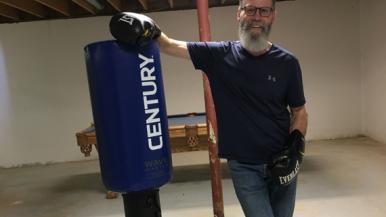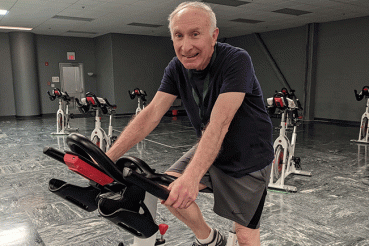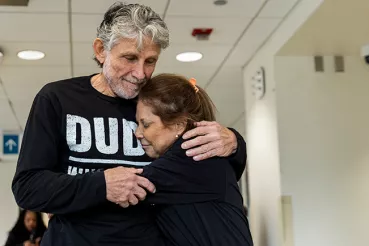Craig Smit was “pretty lost” when he was diagnosed with Parkinson’s disease in 2019. “It was hard to hear those words,” he says. “In fact, it was terrifying.”
But he found new focus, direction and hope through exercise, especially through the Delay the Disease™ and Rock Steady Boxing classes that are part of Rush Copley’s Movement Disorders Program. He credits those classes with slowing the progression of his disease and says, “I’m thrilled it helped bring some of the old me back.”
A Progressive Disorder
Parkinson’s is a progressive nervous system disorder that affects movement. Symptoms include tremors, stiffness and slowing of movement. For the 61-year-old carpenter, it meant the end of a career he had enjoyed for 42 years. He knows he’ll never go back to work full-time as a carpenter but is grateful for what he still can do. “I can still pick up a hammer and swing,” he says, “but no jumping on ladders.”
For 10 years prior to his diagnosis, Craig had experienced knee and back problems and was in and out of physical therapy. Then, his back began locking up and physical therapy was no longer helping. “I had difficulty getting through the day,” he says.
In the summer of 2018, on his daily walk with his dog, he noticed his walk was off – he was shuffling on his left side. Then at dinner, he stabbed his food with a fork, but there was nothing on it. “It was like I forgot how to use silverware,” he says. Things he had done without thinking took a lot of concentration.
Craig went to his sports doctor who sent him to a neurologist. On Valentine’s Day of 2019, he got his diagnosis: Parkinson’s disease.
“I look at my life as before and after my diagnosis,” he says. “It was a long time in getting to the diagnosis, but then things moved quickly.”
Moving Forward
Although he says it is a “heavy experience and a lot to get your brain around,” Craig was soon ready to start moving beyond the initial shock, helped by a great support group. “My wife has been wonderful,” he says. Within days, she found the Movement Disorders program at Rush Copley. Once he entered the program, he shifted gears. “It was a whole new ball game,” he says as it gave him direction, focus and a game plan.
“I’m thrilled it helped bring some of the old me back,” he says. The difference is visible. “Friends who haven’t seen me in a year and a half say I look more alive and focused. I attribute that to Delay the Disease and Rock Steady classes.” He says the classes have helped tremendously with the shuffling and slowing down of his movements. They’ve helped his balance as well. And they’ve helped emotionally.
“I don’t know what I would have done without these guys. They have been a huge help emotionally. I’m a fairly private person. In fact, my wife says I’m a hermit by default,” he jokes. “But I look forward to these classes.” Craig says he gets the most physically from the boxing class because it’s more intense. “We find our limit and push ourselves,” he says. “We already know what we can’t do. We find out what we can do.”
The staff and other participants bring support and a very positive attitude to the program. “You never doubt that the support is there. It’s a very special place and a special bunch of people,” he says. “Everybody brings something to the table. I’ve met some of the most amazing people I’ve ever met in my life, and I can thank Parkinson’s for that. I’m blessed to know them.”
A Setback
In August of 2019, just six months after starting the program, Craig was dealt a setback. He had a minor heart attack, which took him away from Delay the Disease classes for August and September and from boxing class even longer. By October, he was back to Delay the Disease classes but was not able to return to the more strenuous boxing class until December.
Although Craig tries to maintain a positive attitude, he admits he was not a pleasant person for a few weeks after his heart attack – and he didn’t care. “I was angry,” he says. “I thought, ‘Why even bother?’” Within a week or two, he was back on board. “You have to let yourself have that moment, then move on. The road to recovery from my heart attack was really the same road I was already on with Parkinson’s.” That road was exercise. He could feel his Parkinson’s symptoms coming back after the heart attack and was determined to keep from regressing. He tackled cardiotherapy so he could be strong enough to return to the Parkinson’s classes.
He was moving forward again when the coronavirus pandemic hit in March, bringing the classes to a temporary halt.
“I’m really finding out how much I get from the classes now that they’re out of the picture,” he says. “It’s an up and down kind of journey, but it is what it is. I accept it. These are the cards that were dealt me. I make the most out of it.”
Working Out at Home
Since the shelter-in-place order, Craig has been working out at home. His children sent him a freestanding boxing bag, and he has been building his own gym in the basement, picking up lessons online.
“Exercise is my new job,” he says, “and I’m working from home like everyone else.” He works out five days a week for two hours a day. “My main goal is to keep to a schedule and do 10,000 steps a day. I will not allow myself to go back to how I was.” His routine includes boxing, stretching and weight lifting.
He also participates in the movement disorders support group, which has begun meeting virtually. “It was wonderful to see everybody’s faces,” he says of the first virtual meeting, although he adds, “I know the support is there even if we don’t see each other.”
Craig is committed to his fight against Parkinson’s, even when he doesn’t feel like working out. “On bad days when I feel like ‘Why me?’ I look at the people around me and I do it for my family. I know my wife’s independence hinges on my independence. It affects them,” he says, “and that’s a pretty big incentive.”




